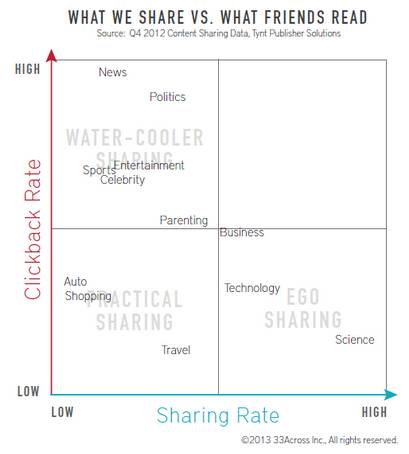New research highlights that social sharing is driven by ego
Summary: ทำไมเราแบ่งปันลิงค์ไปบนเว็บสังคมที่เพื่อนของเราไม่เห็นจะสนใจ แล้วทำไมเรื่องแฟชั่นถึงมีการคลิ๊กกว่าเรื่องธุรกิจนะWhy do we share links on social sites that our friends are not particularly interested in? And why do articles about fashion get a higher percentage of clicks than articles on business?
By Eileen Brown for Social Business
April 12, 2013 — 09:59 GMT (17:59 SGT)
We feel compelled (บังคับ) to share information across our social channels when we find it on the web. But what are our motivations for doing this?
33Across which specialises in social sharing and content discovery has been examining our behaviour online. It has released research from its Tynt publisher solution to examine online sharing behaviour by consumers around the world.
:: 33across.com :: Tynt.com ::
Just like its report on advertising on Facebook post IPO (Initial Public Offering) the research brings up some interesting findings. 33Across examined 450 of its largest publishers across 24 content categories.
“Publishers need to move beyond analyzing which content is most frequently shared and also consider the rate at which people click on shared links“.
It calculated sharing rate by dividing the number of shares by the number of page views for a given site. This normalized the data to provide an apples-to-apples comparison across categories.
Click back rate is calculated by dividing the number of clicks on all shared links for a web site by the number of total shares for the web site.
For example, if site xyz.com has 1,000 total shares and 500 clicks on the shared links, then the click back rate would be 50%.
The raw data comes from the Tynt service and is available through the company’s internal data portal where they have access to account-level information. The sites were manually categorized and data rolled up by category.
The research highlights some interesting behavior.
Obviously we do not share everything we read. Some topics warrant a higher sharing rate per page view than other topics. Science articles score highly. For every 100 science related articles we read, we are likely to share 12 of them with our friends or connections.
Conversely for every 100 articles relating to men’s health, fitness or relationships, we are likely to share only one article with our friends.
But what do your friends actually read? Are they more likely to read something just because you have shared it? Apparently not.
–
Stories with a high percentage of shares, such as science stories (11.8 per cent) have a low percentage of clicks (9 per cent). Stories with a low percentage of shares such as men’s health (1.1 per cent) have a high percentage of clicks (47 per cent).
–
So we are sharing highbrow topic stories that our friends just do not read. So why is that?
เป็นสมมติฐานที่น่าสนใจมาก
I might decide to share a science based article on a topic that I hardly understand with my connections. I am sharing this content because I want to be identified with specific topics that showcase just how much I know about the topic.
33Across.com call this ‘ego sharing’. It enhances my personal brand amongst my connections.
Alternatively I might share an article on parenting (การอบรมเลี้ยงดู) or consumer technology (เทคโนโลยีของผู้บริโภค). These practical articles help my connections with how-to advice. These types of articles are more likely to be clicked upon by my connections as there is practical value to them.
This is ‘practical sharing’ (การแบ่งปันที่ปฏิบัติได้จริง) according to 33Across.
Entertainment and celebrity content is less pro-actively (เชิงรุกน้อย) shared from the original web sites. Perhaps we do not want to admit that we avidly (กระหาย) consume celebrity gossip stories. However, once the content is released on social media, then the click through rates are really high.
This is called ‘water-cooler sharing‘.
The highest click rates are for news. 86 per cent of consumers click these links. But under 2 per cent of us share the links initially. Our motivation for sharing news is partially due to ego sharing and partially due to our desire to break the news to our friends.
We want to share to inform others about breaking news. Consumers are interested in the always on news cycle and click rates are high.
But the highest level of social engagement in the news category was for MailOnline, the digital sister of the Daily Mail, instrument of Paris Brown’s demise.
“MailOnline has grown to become the #1 news and entertainment site in the world in part due to readers discovering our content through social sharing,” said Sean O’Neal, Global CMO of MailOnline.–“Tynt’s category findings validate the extremely high social engagement that we observe every day with our readership.”–“Copying and pasting publisher content is how 82 per cent of online sharing begins,” stated Greg Levitt, GM of Publisher Solutions for 33Across.–“As our category findings reveal, publishers need to move beyond analyzing which content is most frequently shared and also consider the rate at which people click on shared links.Dispelling (การพัดกระจาย) myths (ตำนาน) about content consumption behavior while shedding (การไหล) light on the real motivations of readers is yet another way Tynt is helping publishers improve user acquisition (เข้ายึด) and retention (รักษา) from social channels.“
The research was carried out (ดำเนินการ) by 33Across for sites that are use the Tynt service, and it discovered that sites using its CopyPaste and SpeedShare features increased the number of shares and click backs compared to sites that were not using those tools.
–
Our own ego is driving us to share items that improve our social standing amongst our friends and connections and we hesitate to share items that might not make us look good.
So the deluge (เจิ่งนอง) of content containing pictures of kittens (ลูกแมว) and puppies (ลูกหมา) is not to improve our status amongst our friends but could simply be for the ‘Aww’ (ทุกคน) factor it gives them.
